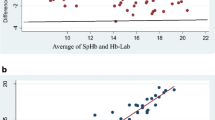Abstract
Background
Maintaining hemoglobin (Hgb) levels within a target range is difficult. Non-invasive hematocrit monitoring (NIVH) continuously monitors both the hematocrit and percent change in intravascular blood volume in real time. Based on the data reported here, NIVH can be utilized as a tool for anemia management in pediatric hemodialysis patients.
Methods
Monthly, mid-week pre-dialysis, Hgb levels were obtained for 12 consecutive months. Concurrent with monthly Hgb, hematocrit was recorded at the start of the dialysis treatment using NIVH. Hgb (oHgb) was calculated using the adult equation Hgb = 0.3112*HCT + 0.71, and a linear regression model was used to derive a pediatric specific equation (pHgb = 0.28*CRIT Hct + 2.5).
Results
A total of 310 observations were obtained from 47 patients. The mean actual hemoglobin (mHgb) was 11.14 ± 1.4, and the mean derived hemoglobin from the adult equation, oHgb, was 10.3 ± 1.3 (p = 0.0001). For the target hemoglobin of 10–12 gm/dl, the adult equation was 72 % sensitive and 63 % specific, whereas the pediatric equation was 93 % sensitive and 70 % specific.
Conclusions
The newly derived pediatric equation (pHgb = 0.28*CRIT Hct + 2.5) improved the prediction capability compared to the standard equation with lower false-negative and false-positive rates.



Similar content being viewed by others
References
KDOQI (2006) Clinical practice guidelines and clinical practice recommendations for anemia in chronic kidney disease. Am J Kidney Dis 47:S11–S145
Brier ME, Gaweda AE, Dailey A, Aronoff GR, Jacobs AA (2010) Randomized trial of model predictive control for improved anemia management. Clin J Am Soc Nephrol 5:814–820
Pattaragarn A, Warady BA, Sabath RJ (2004) Exercise capacity in pediatric patients with end-stage renal disease. Perit Dial Int 24:274–280
Gerson A, Hwang W, Fiorenza J, Barth K, Kaskel F, Weiss L, Zelikovsky N, Fivush B, Furth S (2004) Anemia and health-related quality of life in adolescents with chronic kidney disease. Am J Kidney Dis 44:1017–1023
Jain SR, Smith L, Brewer ED, Goldstein SL (2001) Non-invasive intravascular monitoring in the pediatric hemodialysis population. Pediatr Nephrol 16:15–18
Michael M, Brewer ED, Goldstein SL (2004) Blood volume monitoring to achieve target weight in pediatric hemodialysis patients. Pediatr Nephrol 19:432–437
Gaweda AE, Nathanson BH, Jacobs AA, Aronoff GR, Germain MJ, Brier ME (2010) Determining optimum hemoglobin sampling for anemia management from every-treatment data. Clin J Am Soc Nephrol 5:1939–1945
Mitsnefes MM, Kimball TR, Kartal J, Witt SA, Glascock BJ, Khoury PR, Daniels SR (2006) Progression of left ventricular hypertrophy in children with early chronic kidney disease: 2-year follow-up study. J Pediatr 149:671–675
Schaefer F (2008) Cardiac disease in children with mild-to-moderate chronic kidney disease. Curr Opin Nephrol Hypertens 17:292–297
Amaral S, Hwang W, Fivush B, Neu A, Frankenfield D, Furth S (2006) Association of mortality and hospitalization with achievement of adult hemoglobin targets in adolescents maintained on hemodialysis. J Am Soc Nephrol 17:2878–2885
Stavinoha A, Modem V, Quigley R (2013) Using noninvasive hemoglobin measurements to estimate measured hemoglobin in a pediatric hemodialysis unit. Hemodial Int 17(1):S7–S10
Acknowledgments
The authors gratefully acknowledge the support from Patrick Geer, Kenneth Fairly, and all other dedicated medical staff at Texas Children’s Hospital.
Author information
Authors and Affiliations
Corresponding author
Rights and permissions
About this article
Cite this article
Geer, J.J., Braun, M.C. & Srivaths, P.R. Using a non-invasive method in chronic hemodialysis pediatric patients to estimate hemoglobin. Pediatr Nephrol 30, 661–664 (2015). https://doi.org/10.1007/s00467-014-2967-4
Received:
Revised:
Accepted:
Published:
Issue Date:
DOI: https://doi.org/10.1007/s00467-014-2967-4




